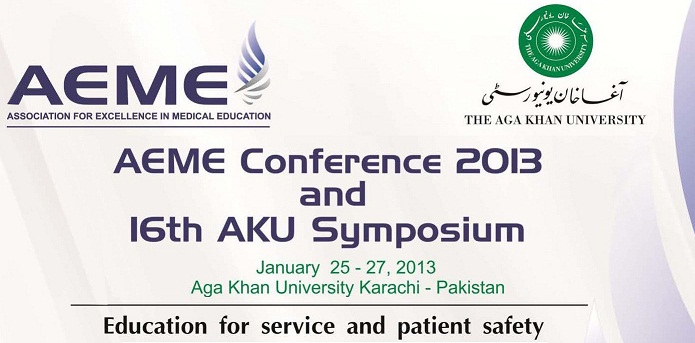Day 1 : Oral Presentations (Theme: Learning Environment)
Determining the medical education environment across multiple undergraduate teaching sites in Pakistan using the DREEM inventory
Location
Lecture Hall 3
Start Date
26-1-2013 4:15 PM
Abstract
Background: Quality of educational environment is one of the most important aspects among the factors associated with effective learning. Understanding students’ perceptions of their educational environment and identification of its strengths and weaknesses can be the first step in taking measures to implement positive changes. The aim of the study was to objectively assess whether the Medical educational environment across multiple undergraduate teaching sites in Pakistan was at an acceptable standard and if its perception among students varied at different institutes and is influenced by gender.
Method: This comparative cross sectional study was conducted across six undergraduate medical institutes in four provinces of Pakistan namely King Edward Medical University, Fatima Memorial Medical College, Dow University of Health sciences, Peshawar Medical College, Ayub Medical College and Bolan Medical College. Dundee Ready Education Environment Measure (DREEM) inventory was administered to all the medical students who consented to take part in the study.
Result: Total respondents were2083 with 1311(63%) females and 773(37%) males. Total Mean DREEM score was found positive (105/200). Students perception of learning was positive (25.1/48), perception of teachers as “in need of some retraining”(22.5/44) & students’ academic self-perceptions was positive (17.2/32). Student’s social self-perception was also positive (15.4/28) while they perceived atmosphere as “having many issues which needs changing”(24.8/48). Female students & preclinical year students’ perceived environment as more positive than male students and students belonging to clinical years.
Conclusion: Mean DREEM score in all medical collegeswas 105/200. Highest score was found in domain of student’s social self-perceptions and lowest in domain of student’s perception of teachers.
Determining the medical education environment across multiple undergraduate teaching sites in Pakistan using the DREEM inventory
Lecture Hall 3
Background: Quality of educational environment is one of the most important aspects among the factors associated with effective learning. Understanding students’ perceptions of their educational environment and identification of its strengths and weaknesses can be the first step in taking measures to implement positive changes. The aim of the study was to objectively assess whether the Medical educational environment across multiple undergraduate teaching sites in Pakistan was at an acceptable standard and if its perception among students varied at different institutes and is influenced by gender.
Method: This comparative cross sectional study was conducted across six undergraduate medical institutes in four provinces of Pakistan namely King Edward Medical University, Fatima Memorial Medical College, Dow University of Health sciences, Peshawar Medical College, Ayub Medical College and Bolan Medical College. Dundee Ready Education Environment Measure (DREEM) inventory was administered to all the medical students who consented to take part in the study.
Result: Total respondents were2083 with 1311(63%) females and 773(37%) males. Total Mean DREEM score was found positive (105/200). Students perception of learning was positive (25.1/48), perception of teachers as “in need of some retraining”(22.5/44) & students’ academic self-perceptions was positive (17.2/32). Student’s social self-perception was also positive (15.4/28) while they perceived atmosphere as “having many issues which needs changing”(24.8/48). Female students & preclinical year students’ perceived environment as more positive than male students and students belonging to clinical years.
Conclusion: Mean DREEM score in all medical collegeswas 105/200. Highest score was found in domain of student’s social self-perceptions and lowest in domain of student’s perception of teachers.

